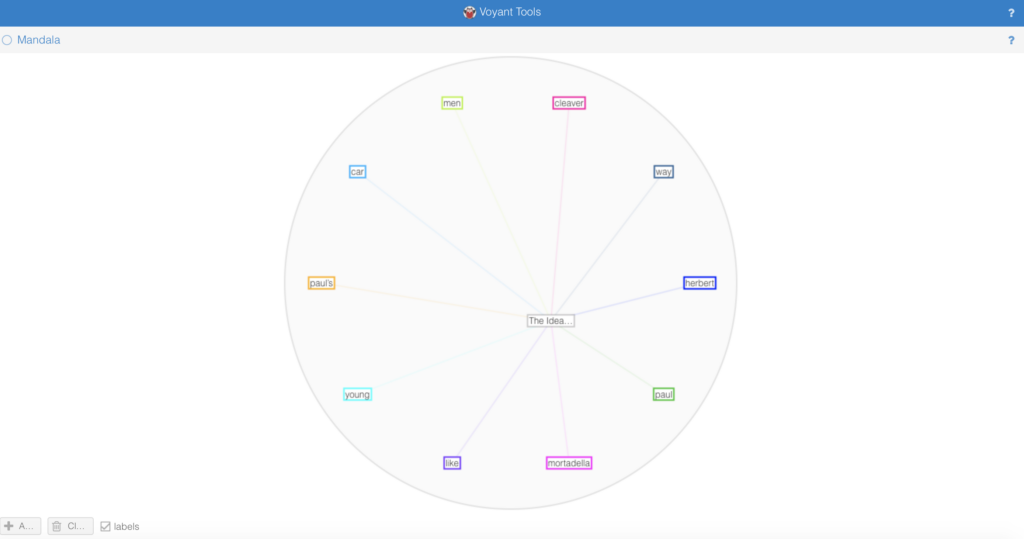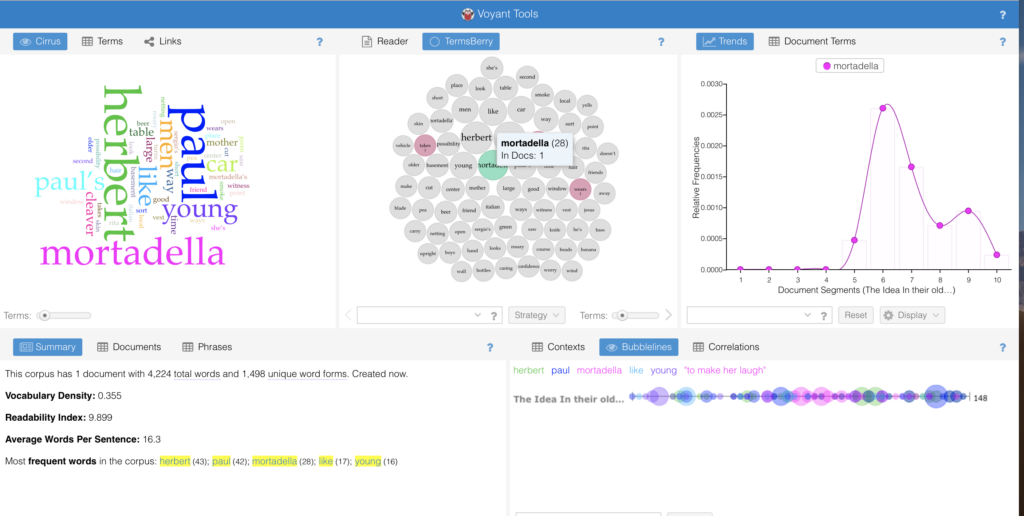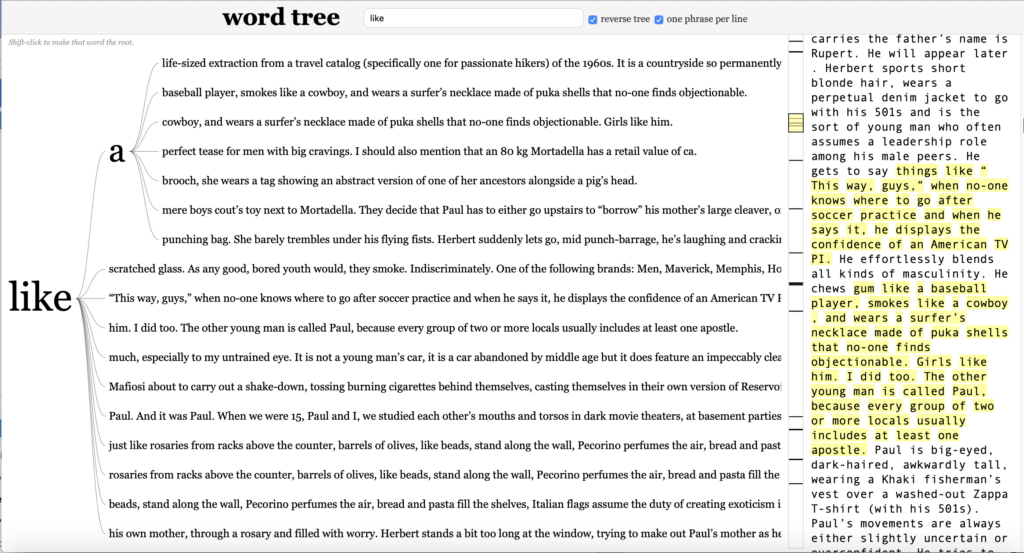Throughout this week’s readings, I noticed the separation between those who analyze and those who provide the “content” that is analyzed, i.e., the separation between the distant readers/researchers and the authors.
Shall these two never meet?
As a person who writes, I began to wonder whether distant reading my own novel draft might yield some productive insight.
While writing, I often find myself in forest-for-the-trees situations, meaning I am deeply in the mud of the moment of my creation (the frog’s perspective) and feel like I am losing my grasp on the story’s overall arc (the bird’s perspective).
To stay connected to the bird’s eye view, authors who work on longer creative projects (and I suppose longer academic projects, too) will often have either a pinboard with index cards or a writing program like Scrivener with features showing the spine of a story digitally.
However, both of these approaches (index card and/or writing software) are still tied to chronology. And one of the intriguing aspects of distant reading is its promise of simultaneity, of translating a time-based piece into a single image. (Or if not entirely ditching chronology, distant reading at least speeds things up.)
How much of a literary work’s overall concept trickles down/is visible in its more fundamental building blocks (words and sentences)? This is a point of curiosity, a question I had not considered before familiarizing myself with distant reading.
I decided to use Voyant and Word Tree to learn a bit more about my own text-in-progress and see how its micro and macro aspects inform each other.
I uploaded the first chapter of a novel to Voyant I am working on and tried to see whether anything interesting would emerge in the “reveal”. I did not have any specific questions, only many vague curiosities. My belief (based on various experiments conducted for Praxis Assignments throughout the semester) remains that having good initial questions is necessary to find a way for these tools to serve us well. Hopefully, the questions get refined in the process of working with the tools, but an initial curiosity is productive and propulsive.
Here is what I learned about my text:
Most insightful was the Mandala feature in Voyant:
It centered the chapter title “The Idea” and showed a list of salient/defining terms within the chapter. The resulting diagram gave me a snapshot of the chapter as a network. It was satisfying to see the story’s main ingredients, almost as if someone had reverse-engineered the text and created the beginnings of a recipe.

Via the Cirrus feature, I learned that I had certainly established my protagonists/main players in the first chapter. Via Trends I saw that the arcs of the main players intersected in ways that confirmed my intentions and intuitions.

So far, I had received mostly confirmations.
More interesting insight came from looking at the “second tier” of usages, the second largest words in the cloud. I noticed that the program treats the possessive of a noun as a distinct entity. I.e., “Paul” and “Paul’s” are different entities as far as Voyant is concerned. Considering both forms together influences (and in this case amplifies) the overall presence of Paul — which aligns with my intentions but was more difficult to see. The strong presence of “Paul’s” also says something about Paul that I hadn’t explicitly considered: He owns more than others. (More characteristics or more goods? Tbd.)
I can see fruitful research questions emerging around the use of the possessive form in my text and the texts of others.
Another aspect that surprised me was the frequent presence of the word “like”. I would not have anticipated this. Here, Word Tree provided an opportunity to look at the context of these “likes” in more detail.

Based on the specific usages, which I could easily surveil via the word tree above, I might consider stylistic changes. Or perhaps I might notice that simile carries outsized responsibility in my text. The frequency of “like” might point to a theme I could make more explicit in revision. (I am thinking about this.)
In summary:
I can see Voyant being especially helpful in the later stages of the revision process for a novel & when evaluating and implementing editorial feedback. Even when using tools like Voyant on your own writing, the insights distant reading affords are most useful paired with close reading. The data visualization can be an impetus for returning to specific sections and close-reading those. (See also the Richard Jean So and Edwin Roland text “Race and Distant Reading” which details a constructive relationship between close and distant reading by looking more closely at Balwin’s Novel “Giovanni’s Room”)
And one sidebar Q:
I am wondering how Voyant’s Cirrus chooses colors. My text is very much about gender, and I noticed that nouns I had designated male kept coming up as blue and green, female coded nouns as pink. Hmmm. Coincidence? This observation made me want to try the software with a text in a very gendered language (like German).



